The polyacrylamide produced by Henan Saceco is mainly used for various wastewater treatment. It can achieve the effect of sludge flocculation and sedimentation, and can also be used for sludge dewatering to achieve sludge drying treatment. Today, let's introduce which types of sludge dewatering machines polyacrylamide is applicable to!
After the wastewater undergoes sedimentation treatment, a large amount of sludge is produced. Even after concentration and digestion treatment, the moisture content still reaches 96%, and the volume is very large, making it difficult to be disposed of. It must undergo dewatering treatment to increase the solid content of the sludge cake to reduce the occupied area of the sludge pile.
Most large and medium-sized wastewater treatment plants adopt mechanical dewatering. There are many types of dewatering machines, and according to the dewatering principle, they can be classified into vacuum filtration dewatering, pressure filtration dewatering, and centrifugal dewatering. This article will explain the working principle, structure, advantages and disadvantages of the commonly selected pressure filter (including belt pressure filter and plate and frame pressure filter), centrifugal dewatering machine and spiral stack sludge dewatering machine in domestic wastewater treatment plants.
1. Spiral Stacked Sludge Dewatering Machine
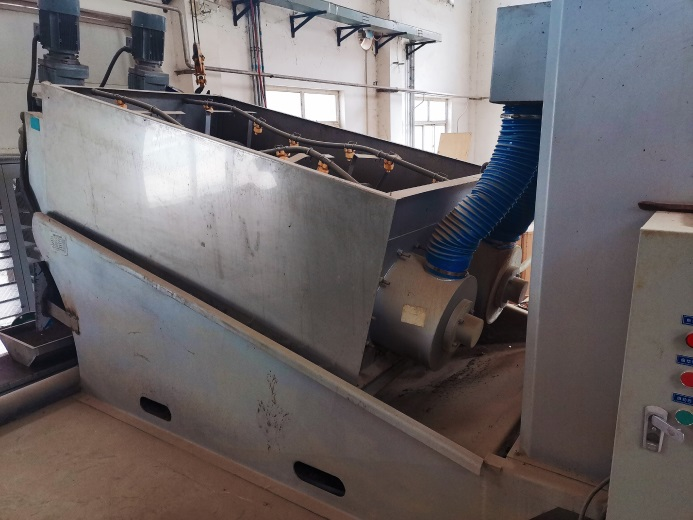
1. Working Principle
(1) Concentration: When the spiral driving shaft rotates, the multiple solid-liquid contact plates located around the driving shaft move relative to each other. Under the action of gravity, water flows out through the gaps between the moving contact plates, achieving rapid concentration.
(2) Dewatering: After the concentrated sludge moves forward with the rotation of the spiral shaft, the pitch of the spiral shaft gradually decreases along the direction of the sludge cake outlet, and the gaps between the rings also gradually narrow. The volume of the spiral cavity continuously shrinks. Under the action of the back-pressure plate at the outlet, the internal pressure gradually increases. With the successive continuous rotation and pushing by the spiral driving shaft, the water in the sludge is squeezed out, and the solid content of the filter cake continuously increases, ultimately achieving continuous dewatering of the sludge.
(3) Self-cleaning: The rotation of the spiral shaft drives the moving ring to rotate continuously. The equipment achieves a continuous self-cleaning process by relying on the movement between the fixed ring and the moving ring, thus ingeniously avoiding the common clogging problem of traditional dewatering machines.
2. Structure
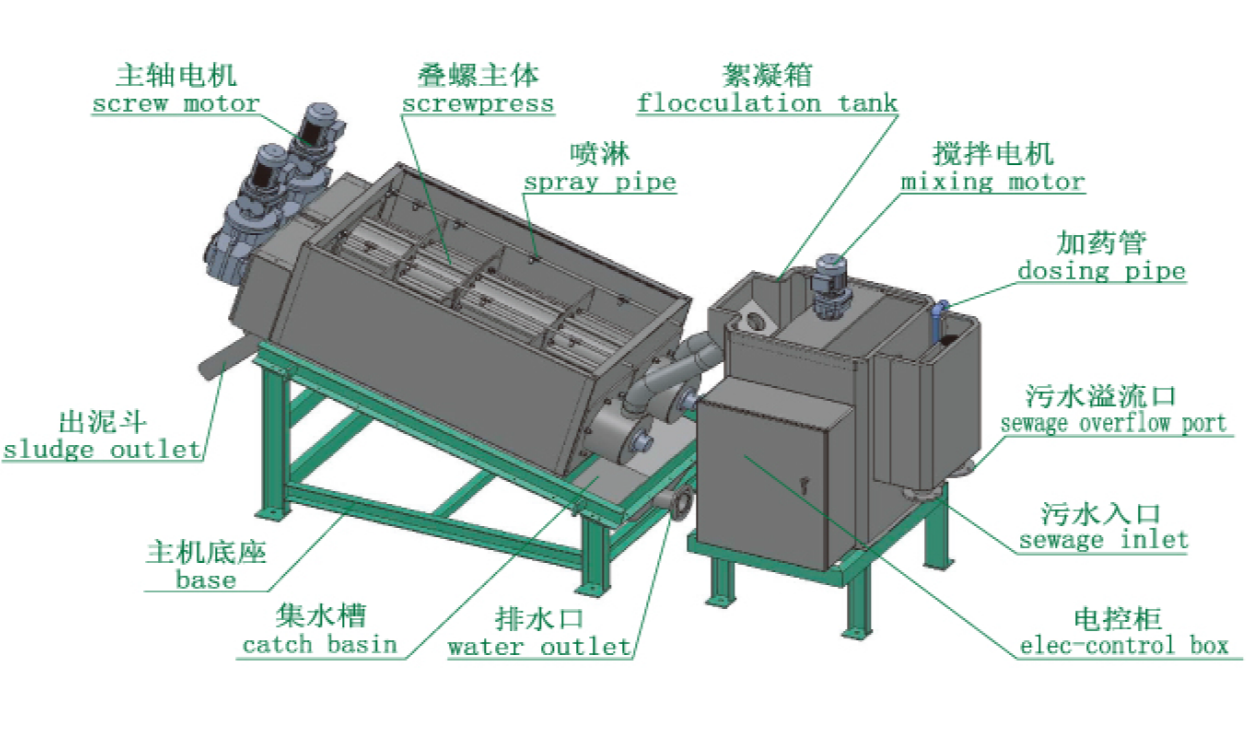
The spiral sludge dewatering machine is composed of a spiral body, a driving device, a filtrate tank, a mixing system, a frame, etc. When the spiral sludge dewatering machine is working, it lifts the sludge to the mixing tank through a sludge pump. At this time, the dosing pump also quantitatively delivers the liquid to the mixing tank. The stirring motor drives the entire stirring system to fully mix the sludge with the liquid, thereby generating flocs. When the liquid level reaches the upper limit of the liquid level sensor, the sensor receives a signal, causing the main body motor of the spiral to work, thus starting the dewatering process and allowing the sludge to flow into the main body of the spiral. Under the action of the spiral shaft, the sludge is gradually lifted to the sludge outlet. The filtrate flows out through the gap between the fixed ring and the moving ring.
II. Plate and Frame Filter Press

1. Principle
The frame filter press consists of a series of alternating filter plates and filter boxes, forming a set of filter chambers. The surface of the filter plates has grooves, and the protruding parts are used to support the filter cloth. The edges and corners of the filter boxes and plates have through holes, which, when assembled, form a complete channel that can introduce the suspension, washing water, and discharge the filtrate. There are handles on both sides of the plates and boxes that are supported on the crossbeam, and the plates and boxes are pressed together by the pressing device. The filter cloth between the plates and boxes serves as a sealing gasket. The feed pump pumps the suspension into the filter chamber, forming filter residue on the filter cloth until the filter chamber is filled. The filtrate passes through the filter cloth and flows along the grooves of the filter plates to the edge corner channels of the plates and boxes, and is then discharged in a concentrated manner. After filtration, washing water can be introduced to wash the filter residue. After washing, sometimes compressed air is also introduced to remove the remaining washing liquid. Then, the filter press is opened to remove the filter residue, clean the filter cloth, re-press the plates and boxes, and start the next working cycle.
2. Structure
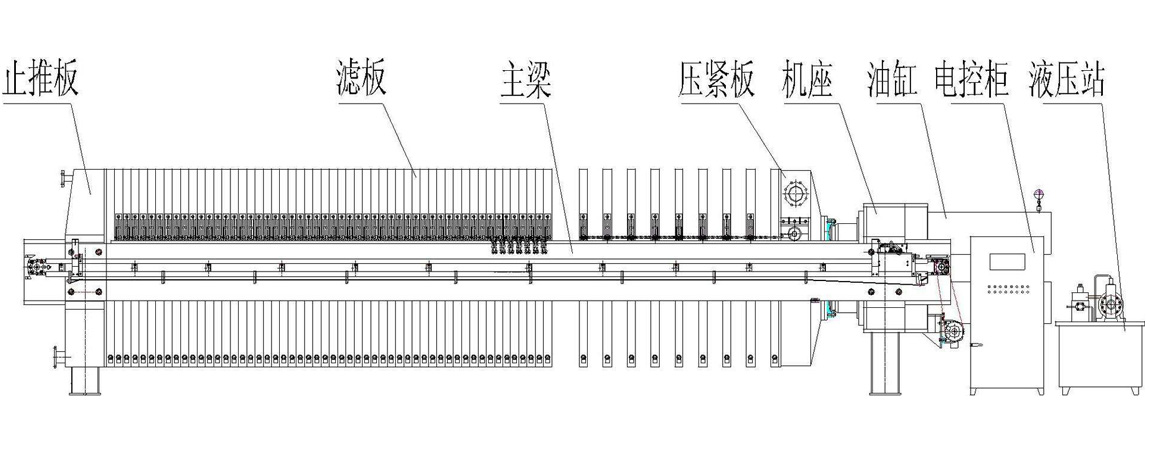
The plate and frame filter press is mainly composed of the thrust plate (fixed filter plate), the pressing plate (movable filter plate), the filter plates and filter frames, the crossbeam (flat iron frame), the filtering medium (filter cloth or filter paper, etc.), the pressing device, the collecting tank, etc.
III. Belt Filter Press
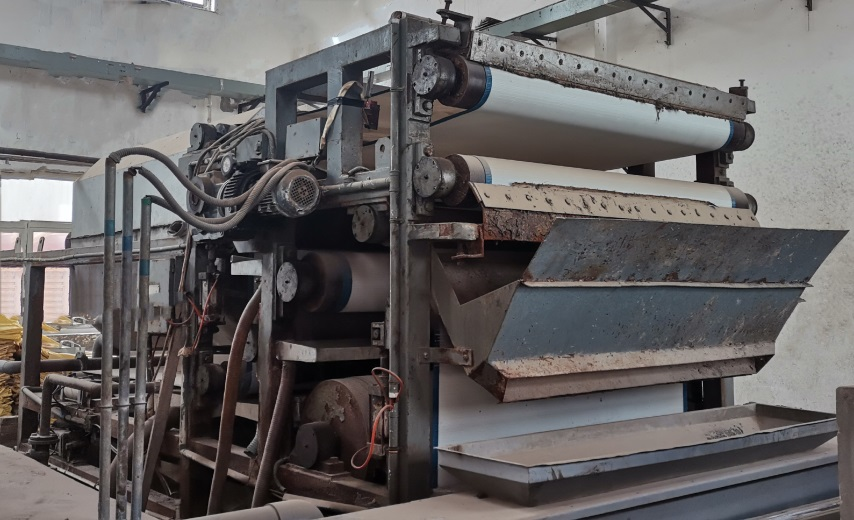
1. Structure and Principle
The belt press filter is mainly composed of the driving device, the transmission drum, the conveyor belt, the slot-type upper idler roller, the lower idler roller, the frame, the cleaner, the tensioning device, the deflection drum, the material guiding chute, the weight tensioning device, and the electrical control device, etc. The conveyor belt forms a closed loop by passing around the transmission drum and the tail deflection drum. The idler rollers bear the conveyor belt and the materials conveyed thereon. The tensioning device provides sufficient tension for the conveyor belt to ensure frictional force between it and the transmission drum, preventing the conveyor belt from slipping. During operation, the reduction motor drives the transmission drum, which in turn drives the conveyor belt to run by means of friction. The materials enter through the feeding device and move along with the conveyor belt, traveling a certain distance before reaching the discharge port and then entering the next process stage.
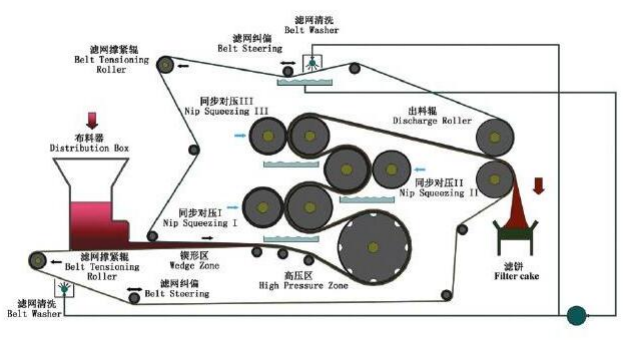
4. Centrifugal Dehydrator

1. Principle
The centrifugal sludge dewatering machine utilizes the density difference between the solid and liquid phases and, under the action of centrifugal force, accelerates the sedimentation speed of solid particles to achieve solid-liquid separation. The specific separation process is that the sludge and the flocculant solution are sent into the mixing chamber of the drum through the inlet pipe. Here, they undergo mixed flocculation (if the flocculant is added before the sludge pump or through the pipeline after the pump, the reaction has already occurred in advance). Due to the high-speed rotation of the rotor (screw and drum) and the frictional resistance, the sludge is accelerated inside the rotor and forms a cylindrical liquid ring layer (liquid ring zone). Under the action of centrifugal force, the heavier solid particles settle on the inner wall of the drum to form a sludge layer (solid ring layer). Then, using the relative speed difference between the screw and the drum, the solid phase is pushed towards the cone end of the drum, and after the liquid surface is discharged (shore zone or called the drying zone), the sludge dries and is dehydrated, and is pushed out through the discharge port to be discharged. The clear liquid is discharged from the large end of the drum to achieve solid-liquid separation.
2. Structure
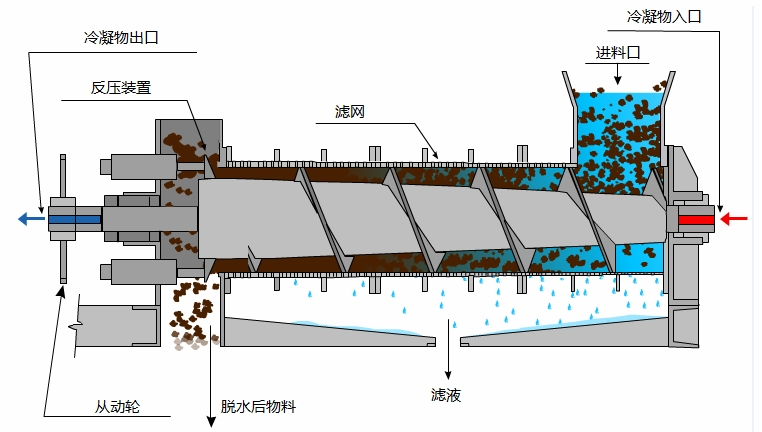
V. Comparison of Several Sludge Dewatering Machines
Serial number |
Name | Method | Advantage |
Disadvantage |
| 1 | Filtering machine with belt |
Continuous dehydration Mechanical compression |
Machine manufacturing is easy, with few ancillary equipment and low energy consumption; it can operate continuously, is convenient to manage, and has a large dehydration capacity. |
The price of polymers is high, the operating cost is expensive, and the dehydration efficiency is lower than that of plate and frame filter presses. |
2 |
Plate and frame filter press |
Intermittent dehydration Hydraulic filtration |
The filter cake has a high solid content, a high solid recovery rate, and low consumption of pharmaceuticals. |
Intermittent operation, with low filtering capacity, and large investment in infrastructure equipment |
3 |
Centrifugal sludge dewatering machine |
Continuous dehydration The effect of centrifugal force |
The infrastructure investment is low, and the land occupation is small; the equipment structure is compact; no or little chemical agents are added; the treatment capacity is large and the effect is good; the total treatment cost is low and the automation level is high; the operation is simple and hygienic. |
Currently, in China, imported centrifuges are mostly used, which are expensive and consume a lot of electricity; the sludge contains sand and gravel, which can easily wear out the equipment and produce certain noise. |
4 |
Stacked helical sludge dewatering machine |
The effect of centrifugal force Continuous dehydration |
Small in size, it saves floor space; low power consumption, equipped with an automatic flushing device, the equipment will not get clogged, the efficiency is highly automated, and it can operate continuously without human intervention for 24 hours. |
The amount of sludge discharged is relatively small, and the moisture content is higher than that of the plate and frame machine. It is suitable for use in places where there are no strict requirements for moisture content. |
If you are interested in our products or have any questions, please fill in the form below. We will contact you immediately after receiving it. Thank you for your choice